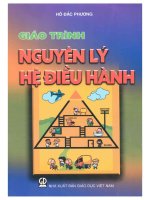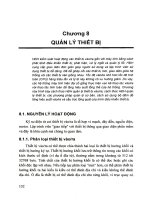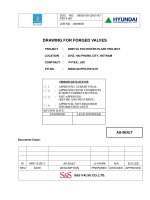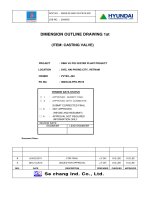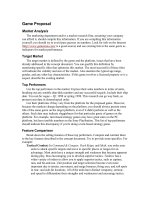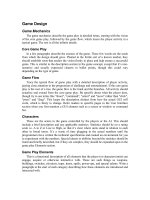Lecture Game design: Game design document - Ho Dac Hung
Bạn đang xem bản rút gọn của tài liệu. Xem và tải ngay bản đầy đủ của tài liệu tại đây (308.28 KB, 30 trang )
GAME DESIGN DOCUMENT
1
GDD
A game design document defines everything in
your game
The one-sheet
The ten-pager
The beat chart
The game design document
2
STEP 1: THE ONE-SHEET
Game title
Intended game systems
Target age of players
Intended Entertainment Software Rating Board
3
(ESRB) rating
A summary of the game’s story, focusing on
gameplay
Distinct modes of gameplay
Unique selling points
Competitive products
ESRB RATINGS
eC (Early Childhood)
E (Everyone)
E10 (Everyone 10+)
T (Teen)
M (Mature 17+)
AO (Adults Only 18+)
4
UNIQUE SELLING POINTS
Unique selling points (or USPs) are the “bullet
points” found on the back of the box.
5
STEP 2: THE TEN-PAGER
The ten-pager is a design document that lays out
the spine of your game.
6
PAGE 1 – TITLE PAGE
Game title
Intended game systems
Target age of players
Intended ESRB rating
Projected ship date
7
PAGE 2 – GAME OUTLINE
Game story summary
Game flow
8
PAGE 3 – CHARACTER
Age,
sex,
and
other
dossier-style
backgroundmaterial can go here . . . as long as
you feel this information does your character
justice.
9
PAGE 4 – GAMEPLAY
Start with the gameplay and detail how the
sequence of play is presented.
10
PAGE 5 – GAME WORLD
Present some images and descriptions of the
game world
11
PAGE 6 - GAME EXPERIENCE
What do players first see when they start the
game?
What emotions/moods are meant to be invoked
by your game?
How are music and sound used to convey your
game’s feel?
How do players navigate the interface?
12
PAGE 7 – GAMEPLAY MECHANICS
13
PAGE 7 – GAMEPLAY MECHANICS
14
PAGE 7 – GAMEPLAY MECHANICS
15
PAGE 7 – GAMEPLAY MECHANICS
16
PAGE 8 – ENEMIES
Enemy character = hazard + AI
Boss character >> enemy character
17
PAGE 9 – MULTIPLAYER AND
BONUS MATERIALS
Bonus materials
Unlockables
Achievements
18
PAGE 10 – MONETIZATION
19
STEP 3: GAMEPLAY
PROGRESSION
Players start from ground zero with no skills, gear,
20
or abilities.
Players have several skills that are presented to
them at the beginning of the game but have to be
unlocked over time.
Players have several skills but have no
knowledge of how to use them yet.
Players have significant power that they can use
immediately only to lose it after a boss fight or
initial confrontation.
…
STEP 4: THE BEAT CHART
Level/environment name
File name (level/environment designation)
Time of day (in context of the game)
Story elements for level
Progression: gameplay focus of the level
Estimated play time of level
Color scheme of level/environment
Enemies/bosses introduced and used
21
STEP 4: THE BEAT CHART
Mechanics introduced and used
Hazards introduced and used
Power-ups found in level/environment
New abilities, weapons, or gear unlocked
Treasure amount and type the players can find
Bonus material found in level/environment
Music
track(s)
level/environment
22
to
be
used
in
this
STEP 5: THE GAME DESIGN
DOCUMENT
Storyboards
Diagrams
Animatics
The beat chart
The team wiki
23
STEP 5: THE GAME DESIGN
DOCUMENT
Table of contents
Revision history
Game goals
Story overview
Game controls
Technological requirements
Front end
Attract mode
Title/start screen
Other screens
24
STEP 5: THE GAME DESIGN
DOCUMENT
Game flowchart
Loading screen
Game cameras
HUD system
Player characters
Player skills
Player inventory tools
Power-ups/state modifiers
Health
Scoring
25

